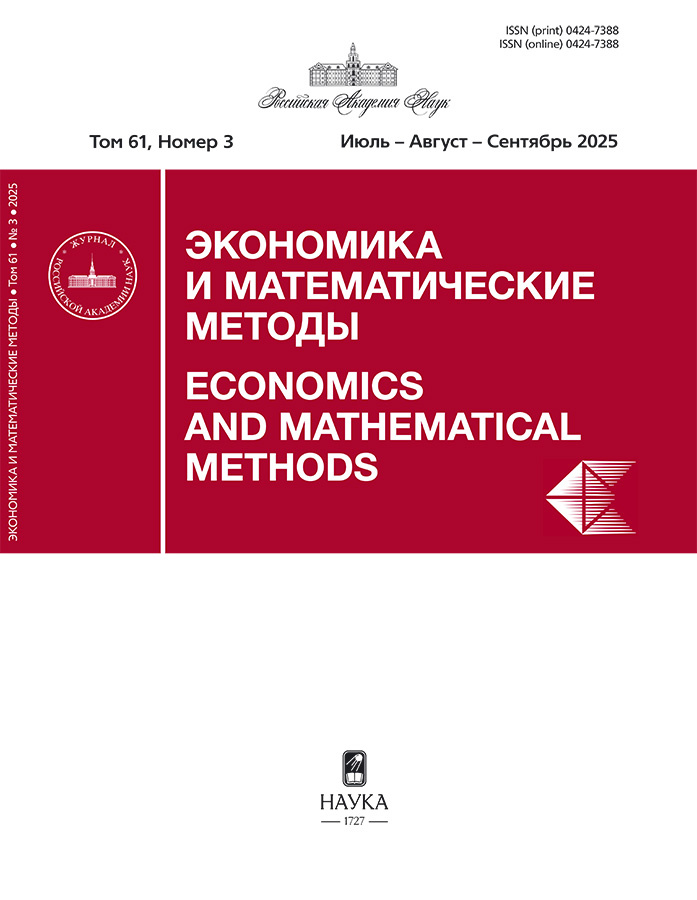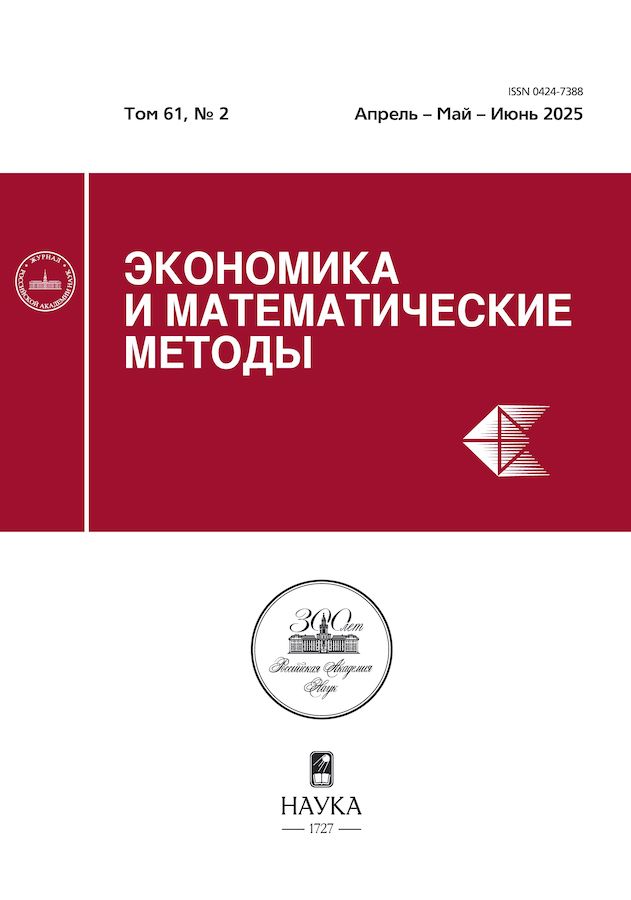Инфляция, экономический рост и денежное предложение в модели переключающихся режимов воспроизводства с континуальным множеством подсистем
- Авторы: Горюнов Е.Л.1,2,3
-
Учреждения:
- Институт экономической политики им. Е. Т. Гайдара
- МГУ им. М. В. Ломоносова
- РАНХиГС
- Выпуск: Том 61, № 2 (2025)
- Страницы: 5-18
- Раздел: Теоретические и методологические проблемы
- URL: https://transsyst.ru/0424-7388/article/view/684342
- DOI: https://doi.org/10.31857/S0424738825020017
- ID: 684342
Цитировать
Полный текст
Аннотация
Модель переключающегося режима воспроизводства (ПРВ) представляет собой гетеродоксальную модель эндогенного роста в непрерывном времени с конечным числом перекрывающихся поколений производственного капитала и монетарным сектором. Отличительная особенность модели ПРВ состоит в том, что в ней нарушается долгосрочная нейтральность денег. Цель настоящей работы — продвинуться в понимании внутренних механизмов модели ПРВ, качественно описать возникающие эффекты и исследовать, как в модели ПРВ денежная политика влияет на рост и инфляцию. Оригинальные модели ПРВ ввиду сложной структуры не допускают решения в явном виде, поэтому теоретический анализ зависимости эндогенных переменных от экзогенных параметров в данных моделях ограничивается исследованием частных численных решений. В статье предложен авторский вариант модели ПРВ с непрерывным множеством поколений капитала, для которого при условии стационарности роста получено приближенное решение модели в явном виде. Показано, что темп денежной эмиссии положительно влияет на инфляцию, при этом влияние эмиссии на рост немонотонно. Проанализированы зависимости темпов роста выпуска и инфляции от других экзогенных параметров. Для всех зависимостей описаны и проинтерпретированы экономические механизмы, обеспечивающие соответствующие зависимости. Проанализировано три варианта денежной политики: политика максимизации роста, политика обеспечения ценовой стабильности и политика компромисса между ростом экономики и инфляцией, предполагающая оптимизацию отношения валовых темпов инфляции к валовым темпам роста выпуска. Критически обсуждаются особенности предпосылок, лежащих в основе модели ПРВ, их роль в обеспечении качественных результатов модели, включая нарушение нейтральности денег.
Полный текст
Об авторах
Е. Л. Горюнов
Институт экономической политики им. Е. Т. Гайдара; МГУ им. М. В. Ломоносова; РАНХиГС
Автор, ответственный за переписку.
Email: gorunov@iep.ru
Россия, Москва; Москва; Москва
Список литературы
- Горюнов Е. Л. (2023). Анатомия теории переключающихся режимов воспроизводства: откуда берутся ненейтральность денег и экономические колебания? // Вопросы экономики. № 127. С. 120–140. doi: 10.32609/0042-8736-2023-12-120-140 [Goryunov E. L. (2023). Theory of the shifting modes of reproduction: Where do the non-neutrality of money and economic cycles come from. Voprosy Ekonomiki, 12, 120–140. doi: 10.32609/0042-8736-2023-12-120-140 (in Russian).]
- Маевский В., Малков С., Рубинштейн А., Красильникова Е. (2019). Об одном направлении развития мезоэкономической теории // Журнал институциональных исследований. Т. 11, № 3. С. 21–38. doi: 10.17835/2076-6297.2019.11.3.021-038 [Mayevsky V., Malkov S., Rubinstein A., Krasilnikova E. (2019). On one direction of development of the mesoeconomics. Journal of Institutional Studies, 11, 3, 21–38 (in Russian).]
- Маевский В., Малков С., Рубинштейн А., Красильникова Е. (2020). Теория воспроизводства капитала и не-нейтральность денег. СПб.: Нестор-История. [Mayevsky V., Malkov S., Rubinstein A., Krasilnikova E. (2020). The theory of reproduction of capital and non-neutrality of money. Saint-Petersburg: Nestor-Istoriya (in Russian).]
- Маевский В. И. (2021). О базовых предпосылках не-нейтральности денег в экономической теории // Journal of Institutional Studies. Т. 13. № 1. С. 6–19. doi: 10.17835/2076-6297.2021.13.1.006-019 [Maevsky V. I. (2021). On the basic preconditions of non-neutrality of money in economic theory. Journal of Institutional Studies, 13, 1, 6–19. doi: 10.17835/2076-6297.2021.13.1.006-019 (in Russian).]
- Маевский В. И. (2024). О возможности таргетирования экономического роста: теоретический аспект // AlterEconomics. Т. 21. № 27 С. 159–178. doi: 10.31063/AlterEconomics/2024.21-2.1 [Maevsky V. I. (2024). On the possibility of targeting economic growth: A theoretical aspect. AlterEconomics, 21, 2, 159–178. doi: 10.31063/AlterEconomics/2024.21-2.1 (in Russian).]
- Маевский В. И., Андрюшин С. А., Малков С. Ю., Рубинштейн А. А. (2016). Денежные механизмы и модель переключающегося режима воспроизводства // Вопросы экономики. № 9. С. 129–149. doi: 10.32609/0042-8736-2016-9-129-149 [Mayevsky V. I., Andryushin S. A., Malkov S. Yu., Rubinstein A. A. (2016). Money mechanisms and the shifting mode of reproduction model. Voprosy Ekonomiki, 9, 129–149 (in Russian).]
- Маевский В. И., Малков С. Ю. (2014). Перспективы макроэкономической теории воспроизводства // Вопросы экономики. № 4. С. 137–155. doi: 10.32609/0042-8736-2014-4-137-155 [Mayevsky V., Malkov S. (2014). Perspectives of the macroeconomic reproduction theory. Voprosy Ekonomiki, 4, 137–155. doi: 10.32609/0042-8736-2014-4-137-155 (in Russian).]
- Маевский В. И., Малков С. Ю., Рубинштейн А. А. (2016). Новая теория воспроизводства капитала: развитие и практическое применение. Москва, Санкт-Петербург: Нестор История. [Mayevsky V. I., Malkov S.Yu., Rubinstein A. A. (2016). New theory of capital reproduction: Development and practical application. Moscow, St. Petersburg: Nestor-Istorya (in Russian).]
- Маевский В. И., Малков С. Ю., Рубинштейн А. А. (2019). Анализ связи между эмиссией, инфляцией и экономическим ростом с помощью модели переключающегося режима воспроизводства // Вопросы экономики. № 8. С. 45–66. doi: 10.32609/0042-8736-2019-8-45-66 [Mayevsky V. I., Malkov S.Yu., Rubinstein A. A. (2019a). Analysis of the relationship between issuing money, inflation and economic growth with the help of the SMR-model. Voprosy Ekonomiki, 8, 45–66. doi: 10.32609/0042-8736-2019-8-45-66 (in Russian).]
- Маевский В. И., Малков С. Ю., Рубинштейн А. А. (2023). Макроэкономические условия перехода России к высоким темпам роста: опыт Х-экономики Китая // Вопросы экономики. № 10. С. 98–123. doi: 10.32609/0042-8736-2023-10-98-123 [Mayevsky V. I., Malkov S.Yu., Rubinstein A. A. (2023). Macroeconomic conditions of Russia’s transition to high growth rates: China’s experience. Voprosy Ekonomiki, 10, 98–123. doi: 10.32609/0042-8736-2023-10-98-123 (in Russian).]
- Маевский В. И., Малков С. Ю., Рубинштейн А. А. (2024). К дискуссии о переключающемся режиме воспроизводства // Вопросы экономики. № 7. С. 136–153. doi: 10.32609/0042-8736-2024-7-136-153 [Maevsky V. I., Malkov S. Y., Rubinstein A. A. (2024). To a discussion on the shifting mode of reproduction. Voprosy Ekonomiki, 7, 136–153. doi: 10.32609/0042-8736-2024-7-136-153 (in Russian).]
- Маевский В. И., Рубинштейн А. А. (2021). Концепция макроэкономической политики компромисса между инфляцией и ростом // Журнал экономической теории. Т. 18. № 4. С. 485–496. doi: 10.31063/2073-6517/2021.18-4.1 [Maevsky V. I., Rubinstein A. A. (2021). The concept of macro-economic policy based on the compromise between inflation and growth. Journal of Economic Theory / AlterEconomics, 18, 4, 485–496. doi: 10.31063/2073-6517/2021.18-4.1 (in Russian).]
- Aghion P., Howitt P. (1992). A model of growth through creative destruction. Econometrica, 60, 2, 323–351.
- Barro R., Sala-i-Martin X. (2004). Economic growth. Second edition. Cambridge: MIT Press.
- Bessen J. E. (1997). Productivity adjustments and learning-by-doing as human capital. CES Bureau of the Census. WP 97–17.
- Foster A. D., Rosenzweig M. R. (1995). Learning by doing and learning from others: Human capital and technical change in agriculture. Journal of political Economy, 103, 67, 1176–1209.
- Haq M., Luqman M. (2014). The contribution of international trade to economic growth through human capital accumulation: Evidence from nine Asian countries. Cogent Economics & Finance, 2, 1, 1–13. doi: 10.1080/23322039.2014.947000
- Jedwab R., Romer P., Islam A. M., Samaniego R. (2023). Human capital accumulation at work: Estimates for the world and implications for development. American Economic Journal: Macroeconomics, 15, 3, 191–223. doi: 10.1257/mac.20210002
- Lucas R. E. (1993). Making a miracle. Econometrica, 61, 2, 251–272. doi: 10.2307/2951551
- Thach N. (2020). Learning-by-doing effect: Evidence from firms of an emerging economy. Accounting, 6, 5, 795–804. doi: 10.5267/j.ac.2020.6.003
- Walsh C. E. (2017). Monetary theory and policy. Cambridge: MIT Press.
Дополнительные файлы













